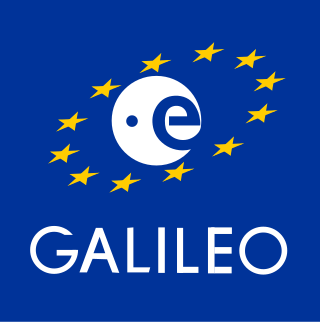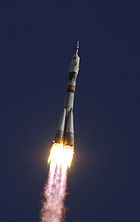
Ariane 5 is a retired European heavy-lift space launch vehicle developed and operated by Arianespace for the European Space Agency (ESA). It was launched from the Centre Spatial Guyanais (CSG) in French Guiana. It was used to deliver payloads into geostationary transfer orbit (GTO), low Earth orbit (LEO) or further into space. The launch vehicle had a streak of 82 consecutive successful launches between 9 April 2003 and 12 December 2017. Since 2014, Ariane 6, a direct successor system, is in development.

Arianespace SA is a French company founded in 1980 as the world's first commercial launch service provider. It undertakes the operation and marketing of the Ariane programme. The company offers a number of different launch vehicles: the heavy-lift Ariane 6 for dual launches to geostationary transfer orbit, and the solid-fueled Vega series for lighter payloads.

Galileo is a global navigation satellite system (GNSS) that went live in 2016, created by the European Union through the European Space Agency (ESA), operated by the European Union Agency for the Space Programme (EUSPA), headquartered in Prague, Czechia, with two ground operations centres in Fucino, Italy, and Oberpfaffenhofen, Germany. The €10 billion project is named after the Italian astronomer Galileo Galilei.

Soyuz is a family of expendable Russian and Soviet carrier rockets developed by OKB-1 and manufactured by Progress Rocket Space Centre in Samara, Russia. With over 2,000 flights since its debut in 1966, the Soyuz is the rocket with the most launches in the history of spaceflight.

The Guiana Space Centre, also called Europe's Spaceport, is a European spaceport to the northwest of Kourou in French Guiana, a region of France in South America. Kourou is located approximately 310 mi (500 km) north of the equator at a latitude of 5°. In operation since 1968, it is a suitable location for a spaceport because of its equatorial location and open sea to the east.

Vega is an expendable launch system in use by Arianespace jointly developed by the Italian Space Agency (ASI) and the European Space Agency (ESA). Development began in 1998 and the first launch took place from the Guiana Space Centre on 13 February 2012.
Fregat (Russian: Фрегат, frigate) is an upper stage developed by NPO Lavochkin in the 1990s, which is used in some Soyuz and Zenit launch vehicles, but is universal and can be used as a part of a medium and heavy class launch vehicles. Fregat became operational in February 2000. Its liquid propellant engine uses UDMH and N2O4. Fregat's success rate is 97.3%, (with 2 failures and 1 partial failure), which makes it one of the most reliable upper stages in the world. Fregat has successfully delivered more than 300 payloads into different orbits. It remains the only upper stage in the world that can place its payload into 3 or more different orbits in a single launch.

Soyuz-2 is a modernised version of the Soviet Soyuz rocket. In its basic form, it is a three-stage launch vehicle for placing payloads into low Earth orbit. Compared to the previous versions of the Soyuz, the first-stage boosters and two core stages feature uprated engines with improved injection systems. Digital flight control and telemetry systems allow the rocket to be launched from a fixed launch platform, whereas the launch platforms for earlier Soyuz rockets had to be rotated as the rocket could not perform a roll to change its heading in flight.

ELA-3, is a launch pad and associated facilities at the Centre Spatial Guyanais in French Guiana. ELA-3 was operated by Arianespace as part of the expendable launch system for Ariane 5 launch vehicles. As of July 2023, 117 launches have been carried out from it, the first of which occurred on 4 June 1996. The final launch occurred on 5 July 2023.

The year 2011 saw a number of significant events in spaceflight, including the retirement of NASA's Space Shuttle after its final flight in July 2011, and the launch of China's first space station module, Tiangong-1, in September. A total of 84 orbital launches were conducted over the course of the year, of which 78 were successful. Russia, China and the United States conducted the majority of the year's orbital launches, with 35, 19 and 18 launches respectively; 2011 marked the first year that China conducted more successful launches than the United States. Seven crewed missions were launched into orbit during 2011, carrying a total of 28 astronauts to the International Space Station. Additionally, the Zenit-3F and Long March 2F/G carrier rockets made their maiden flights in 2011, while the Delta II Heavy made its last.

The Ensemble de Lancement Soyouz (ELS) is a launch complex at the Guiana Space Centre in Kourou/Sinnamary, French Guiana. It was used by Soyuz-ST rockets: modified versions of the Soyuz-2 optimised for launch from Kourou under Soyuz at the Guiana Space Centre programme.

In 2014, the maiden flight of the Angara A5, Antares 120 and Antares 130 took place.

The Georges Lemaître ATV, or Automated Transfer Vehicle 5 (ATV-5), was a European uncrewed cargo spacecraft, named after the Belgian astronomer Georges Lemaître. The spacecraft was launched during the night of 29 July 2014, on a mission to supply the International Space Station (ISS) with propellant, water, air, and dry cargo. It was the fifth and final ATV to be built and launched. Georges Lemaître was constructed in Turin, Italy, and Bremen, Germany. Cargo loading was completed in Guiana Space Center on 23 July 2014.

Ariane 6 is a European expendable launch system developed by ArianeGroup on behalf of the European Space Agency (ESA). It replaces the Ariane 5, as part of the Ariane launch vehicle family. The stated motivation for Ariane 6 was to halve the cost compared to Ariane 5, and increase the capacity for the number of launches per year.
ELA-4, is a launch pad and associated facilities at the Centre Spatial Guyanais in French Guiana located along the Route de l'Espace in the Roche Christine site, between ELA-3 and ELS launch facilities. The complex is composed of a launch pad with mobile gantry, an horizontal assembly building and a dedicated launch operations building. ELA-4 is operated by Arianespace as part of the Ariane 6 program. As of November 2022 the first launch is scheduled for the fourth quarter of 2023.

Soyuz flight VS22 was a rocket launch conducted by multinational launch service provider Arianespace. It was the sixteenth launch of a Soyuz-ST-B launch vehicle, and the 22nd launch of a Soyuz-2 series launch vehicle from the Ensemble de Lancement Soyouz at the Guiana Space Centre. After two scheduling delays and a 33-minute logistical delay, the rocket lifted off on 4 April 2019, and successfully delivered to medium Earth orbit the final four satellites in the O3b broadband satellite constellation, which services Latin America, Africa, and Oceania. After four previous Soyuz flights delivered the constellation's first sixteen satellites, the launch increased the constellation's throughput by 26 per cent. The flight marked the second occasion in which two Soyuz-2 launch vehicles were launched on the same day, occurring hours after the launch of Progress MS-11 from the Baikonur Cosmodrome.

Vega flight VV16, also called SSMS PoC Flight, was the 16th launch of the Vega rocket. The launch was also notable as it was the first Vega launch following the accident of the VV15 launch in July 2019 that caused the loss of FalconEye1 satellite.


















